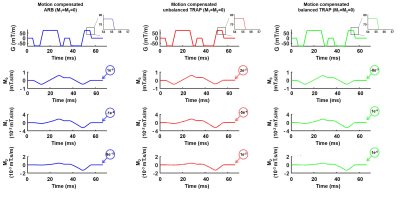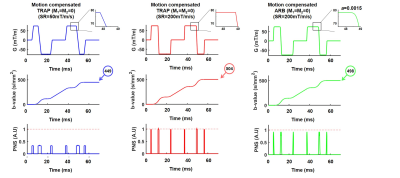Kevin Moulin1,2,3, Mike Loecher1,2, Matthew J Middione1,2, and Daniel B Ennis1,2,3
1Department of Radiology, Stanford University, Stanford, CA, United States, 2Department of Radiology, Veterans Administration Health Care System, Palo Alto, CA, United States, 3Cardiovascular Institute, Stanford University, Stanford, CA, United States
1Department of Radiology, Stanford University, Stanford, CA, United States, 2Department of Radiology, Veterans Administration Health Care System, Palo Alto, CA, United States, 3Cardiovascular Institute, Stanford University, Stanford, CA, United States
ARB
waveforms can precisely meet their design constraints defined in the numerical
optimization while their conversion to TRAP waveforms lead to higher residual
gradient moments. For symmetric design, ARB waveforms offer higher b-value
than TRAP’s while better mitigating PNS.

Figure 2: Asymmetric motion compensated (M1=M2=0)
arbitrary (ARB) waveform optimally designed with GrOpt (blue) and the corresponding
trapezoidal (TRAP) implementation before (red) and after (green) balancing.
Temporal evolution of the zero (M0), first (M1) and
second (M2) order gradient moments are represented for each
waveform. ARB has the lowest residual moments, followed by balanced TRAP, then
unbalanced TRAP.

Figure 4: Symmetric motion
compensated trapezoidal (TRAP) waveforms (M1=M2=0) with
SRlimit=50mT/m/s (blue) and SRmax=200mT/m/s (red) are
compared to an arbitrary (ARB) cubic ramp-up waveform (green). For this scanner
setup the best cubic ramp-up shape parameter was obtained for a=1.5x10-3. The temporal
evolution of the b-value as well as the peripheral nerve stimulation (PNS) plots
are represented for each waveform. As marked by the red dashed line, a PNS ≥1
indicates potential stimulation.
